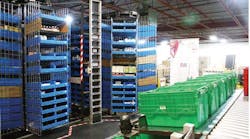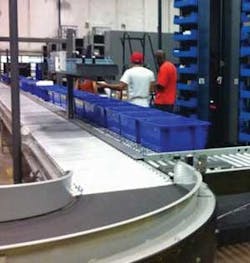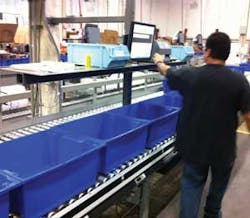Were you ever the person not picked for a friendly pickup game of basketball or other team sport? Maybe you had the right stuff but were misunderstood. If you believe the latest chatter about robots, then horizontal carousels are likely to get some hurt "feelings."
These systems are one of the most misunderstood and wrongly applied technologies in the history of warehousing. And, with the emergence of shuttle technologies and the growth of mini-load systems, it only hurts the case for horizontal carousels. However, I would argue that no automated system is a perfect fit for every application. And more and more, the warehousing team is made up of many types of equipment and technology. The right approach is to understand the profile of the alternative teammates and apply the options that properly support your specific business needs. That approach will result in the best lineup for your distribution center (DC).
Player Profile
Horizontal carousels require 50 to70 percent less floor space than a conventional shelving/racking layout design for similar products and volumes. The resulting reduction in walking time is one of the biggest labor benefits to these systems. A horizontal carousel system is a collection of shelving units (bins) that rotate on a horizontal axis to bring products to a stationary operator (classic part-to-operator technology). They are a high-density storage system typically for handling smaller and lighter products (less than 50 pounds) but can be customized to handle a wide range of products. The length of systems depends on the number and width of the bins on the carousel. Most systems have 18"-24" wide and deep bins and include up to 100 bins, making the overall length approximately 80 feet.A pod of carousels is an effective design for getting the most out of a system. This typically combines three carousels, allowing the operator to work from all three at one workstation. The concept enables one or two carousels to spin to the proper bin, while the operator is picking or stocking from the third. A key component of this system is integrating pick-to-light using a "light tree" and parallel batch sort-to-light workstation. The productivity of this design averages 200 to 300 lines per hour, depending on a multitude of factors including any value-add service requirements, size of products, slotting and replenishment of the system. Carousels systems can be stacked, in which case a platform is the most common approach to reaching the second "floor."
With the emergence of shuttle technology and the proven success of mini-load systems, the manufacturers and integrators of horizontal carousels continue to push the automation level of typical carousel designs. Newer advancements include designs with extractors that automatically remove totes or cases and move them using conveyor systems for delivery to shipping.
The biggest knock on horizontal carousels is the replenishment process. It's not efficient to pick and replenish at the same time with carousels -- something that is done easily with conventional picking, mini-loads and shuttles. The best strategies for replenishment are to size bin shelves to hold a minimum of two weeks on hand (or the entire inventory), perform stocking on a second shift, and/or try to integrate it during the picking operation. Many systems have intelligent bin size utilization and prime height applications to minimize replenishment. Carousels also require constant analysis to fully utilize their efficiency, including moving fast movers to prime picking locations and relocated slower moving products to higher shelf locations.
Lineup Options
For picking orders with small to medium-size items and average/higher volumes, there is a range of options, including pallet racking, shelving, carton flow rack, order pickers, carts, carousels, mini-loads and shuttles, to name a few. The evaluation criteria for picking your team may include space constraints, capital investment, labor productivity and/or throughput. If your budget is limited, then a conventional design might be the only option, but it is possible horizontal carousels are an option as they cost less than the highly automated systems. If the budget is not an issue and higher throughput is the primary objective, then mini-loads and shuttle technologies are good possibilities.
There is no straightforward answer for selecting your lineup, which means a detailed analysis -- including simulation modeling -- is often used to justify higher cost automated solutions. The important first steps involve collecting product dimensional data, defining the throughput capacity required, forecasting the growth of the business and defining your space constraints. And, know your budget going into the project and set the expectations for the required return on investment.
When to Use Horizontal Carousels
While there are many potential candidates for a solution, the most likely position for horizontal carousels on your team is when you have a piece-pick operation, medium cube items, smaller amounts of inventory and medium/higher pick volumes. In addition, horizontal carousels are a top candidate if you have limited floor space, odd-shaped items or products with security priorities. The common applications are maintenance parts distribution, automobile parts distribution, production line support, service parts, kitting, records keeping and e-commerce.
Retail e-commerce operations are increasingly considering horizontal carousels as volumes often fall within the low to medium range. Additionally, the automated designs for most retail distribution centers don't support the one- or two-line orders common with e-commerce. But, setting up a horizontal carousel system in the corner of a DC can be an effective solution for fulfilling these e-commerce orders.
The enclosed environment provided by carousels makes them ideal for handling high-security items. And, given they can be designed to provide an enclosed, climate-controlled environment, they can be used for cold storage. The top industry for these requirements is pharmaceuticals, although many of these applications use vertical carousels (but that's another story).
A Case for Carousels: Dal-Tile
Dal-Tile makes and distributes ceramic tile and natural stone. Combined with their parent company, Mohawk Industries, they manufacture nearly 700 million square feet of floor covering per year. Samples are a large part of the business, in order to sell their assortment of products. The Dal-Tile Sunnyvale, Texas, Distribution Center was fulfilling sample requests from their large warehouse using order picker trucks and picking from the floor locations within pallet rack. The DC operations team knew there had to be a better approach, as the business continued to grow in the number of samples and volume. The internal project team, led by T.J. McCarthy, David Knight and the IT team, put together an analysis of the options. Streamline Integrated was the integrator for the design, system and implementation. The carousel runs on its own warehouse control system, from Celution Software Products, called Pick Pro WCS which is integrated to RedPrairie. Jason Hall, the lead for the carousel, says it was the right answer, and started off small using it for the most frequently sent out samples. Since the installation, the team has gradually ramped up on filling it up with more and more SKUs.The Final Line-up
In setting your automation line-up, consider that the obvious team might result in the lowest productivity. Model the automation supporting your design requirements, then build the best team possible given your constraints. Horizontal carousels might be the underdog to root for on your new team.
Norm Saenz Jr., is managing director of St. Onge Company, a York, Pa.-based consulting firm specializing in planning, engineering and implementing warehousing, manufacturing and logistics operations. He is located in Dallas. Contact him at 817-919-1753 (mobile), 717-840-8181 (main) or [email protected]







